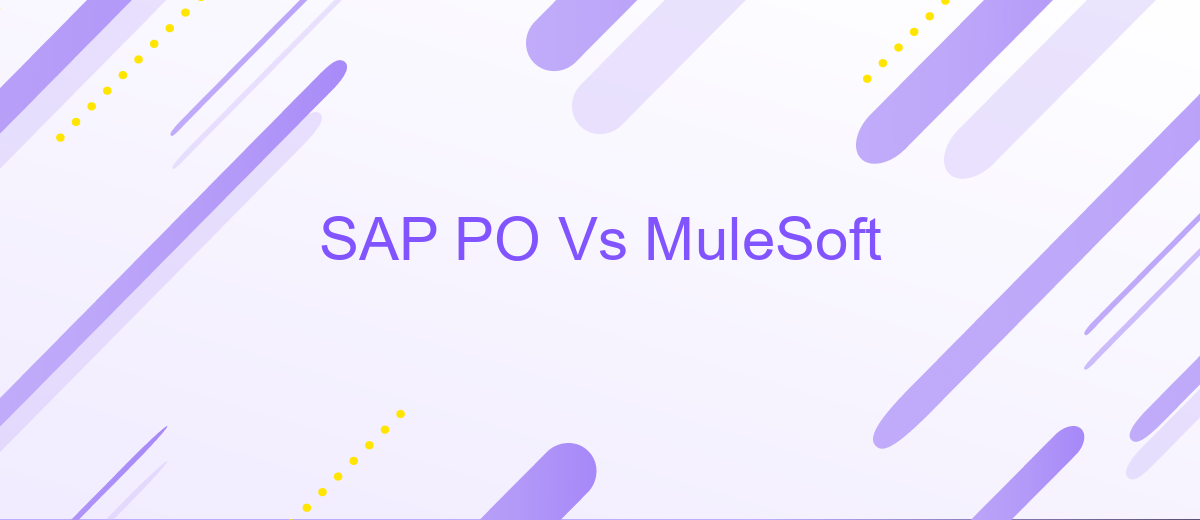SAP PO Vs MuleSoft
In the rapidly evolving landscape of enterprise integration, choosing the right platform is crucial for seamless operations. This article delves into a comparative analysis of SAP Process Orchestration (SAP PO) and MuleSoft, two leading integration solutions. By evaluating their features, capabilities, and use cases, we aim to provide insights to help businesses make an informed decision tailored to their specific needs.
Introduction
In today's fast-paced digital landscape, businesses are increasingly relying on integration platforms to streamline their operations and enhance connectivity across various systems. Two prominent players in this domain are SAP Process Orchestration (SAP PO) and MuleSoft. Both platforms offer robust solutions for integrating diverse applications, data sources, and services, but they cater to different needs and preferences.
- SAP PO: A comprehensive middleware platform designed for enterprise-level integration, focusing on SAP environments.
- MuleSoft: A versatile integration platform that supports a wide range of applications and APIs, suitable for both cloud and on-premise deployments.
Choosing the right integration platform can significantly impact an organization's efficiency and agility. While SAP PO excels in environments heavily invested in SAP technologies, MuleSoft offers greater flexibility and broader connectivity options. Additionally, services like ApiX-Drive can further simplify the integration process by providing user-friendly tools to connect various applications without extensive coding. Understanding the strengths and limitations of each platform is crucial for making an informed decision that aligns with your business goals.
Key Differences

SAP PO (Process Orchestration) and MuleSoft are both powerful integration platforms, but they have key differences that set them apart. SAP PO is a comprehensive middleware solution designed primarily for SAP environments, offering robust capabilities for process integration, business process management, and service-oriented architecture. It excels in scenarios where deep integration with SAP systems is required, providing seamless connectivity and extensive support for SAP-specific protocols and standards.
On the other hand, MuleSoft is a versatile integration platform known for its ability to connect a wide range of applications, data sources, and APIs, regardless of their underlying technology. MuleSoft's Anypoint Platform provides a unified solution for API management, design, and analytics, making it ideal for organizations looking to create a connected ecosystem. Additionally, services like ApiX-Drive can enhance MuleSoft's capabilities by offering automated workflows and integrations between various applications, further simplifying the integration process. While SAP PO is tailored for SAP-centric environments, MuleSoft offers broader compatibility and flexibility for diverse integration needs.
Use Cases

When choosing between SAP PO and MuleSoft, it's essential to consider the specific use cases each platform excels in. Both platforms offer robust integration capabilities, but their strengths vary depending on the scenario.
- Enterprise Resource Planning (ERP) Integration: SAP PO is highly effective for integrating SAP ERP systems with other enterprise applications, providing seamless data flow and process automation.
- API Management: MuleSoft shines in scenarios where API management and development are crucial. Its Anypoint Platform offers comprehensive tools for designing, deploying, and managing APIs.
- Cloud and Hybrid Integration: MuleSoft's cloud-native architecture makes it ideal for integrating cloud-based applications and services, while SAP PO is better suited for on-premises or hybrid environments.
- Third-Party Application Integration: Services like ApiX-Drive can complement both SAP PO and MuleSoft by providing pre-built connectors and automation tools to streamline the integration of various third-party applications.
Ultimately, the choice between SAP PO and MuleSoft depends on your organization's specific integration needs, existing infrastructure, and long-term digital transformation goals. Evaluating these factors will help determine the best fit for your use cases.
Evaluation Criteria

When evaluating SAP PO and MuleSoft, it's crucial to consider various criteria to determine which platform best suits your integration needs. Both platforms offer robust capabilities, but their effectiveness can vary based on specific requirements.
First, assess the ease of use and learning curve associated with each platform. Consider how quickly your team can become proficient in using the tools and whether extensive training is required. Additionally, evaluate the flexibility and scalability of the platforms to ensure they can grow with your business.
- Ease of use and learning curve
- Flexibility and scalability
- Integration capabilities
- Cost and licensing
- Support and community resources
Another important factor is the integration capabilities of each platform. Evaluate how well they integrate with existing systems and third-party applications. Tools like ApiX-Drive can simplify the integration process, making it easier to connect various applications without extensive coding. Finally, consider the cost, licensing options, and the availability of support and community resources to ensure you have the necessary assistance when needed.
Conclusion
In conclusion, both SAP PO and MuleSoft offer robust integration capabilities, each with its unique strengths and weaknesses. SAP PO is well-suited for organizations deeply embedded in the SAP ecosystem, providing seamless integration with SAP applications and strong support for enterprise-level processes. On the other hand, MuleSoft stands out with its versatility and extensive support for a wide range of applications and protocols, making it an excellent choice for businesses seeking flexibility and scalability in their integration solutions.
When deciding between the two, it's essential to consider your organization's specific needs, existing infrastructure, and long-term integration strategy. Additionally, leveraging services like ApiX-Drive can further simplify the integration process, offering user-friendly tools and pre-built connectors that bridge the gap between different systems effortlessly. Ultimately, the right choice will depend on aligning the capabilities of the integration platform with your business objectives and technical requirements.
- Automate the work of an online store or landing
- Empower through integration
- Don't spend money on programmers and integrators
- Save time by automating routine tasks
FAQ
What are the key differences between SAP PO and MuleSoft?
Which platform is better for integrating non-SAP systems?
How do the licensing models of SAP PO and MuleSoft differ?
Can I use cloud-based automation services with both SAP PO and MuleSoft?
Which platform offers better support for API management?
Time is the most valuable resource in today's business realities. By eliminating the routine from work processes, you will get more opportunities to implement the most daring plans and ideas. Choose – you can continue to waste time, money and nerves on inefficient solutions, or you can use ApiX-Drive, automating work processes and achieving results with minimal investment of money, effort and human resources.


